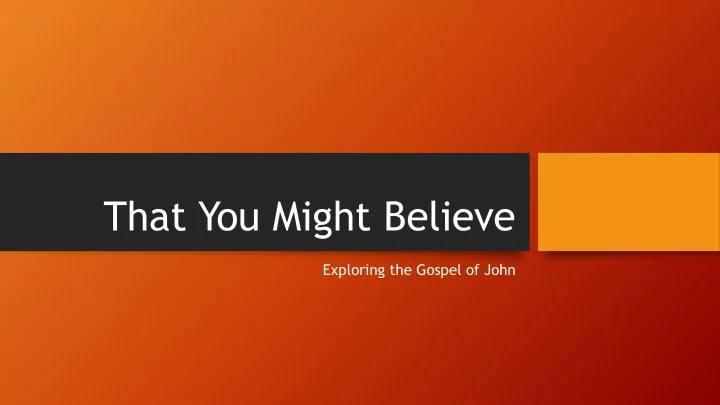

That You Might Believe Exploring the Gospel of John
Revelation of Glory to the World • Glory is a divine attribute in the New Testament • Particularly true for John • Uses the word doxa 16x, more than any other book in the NT • John understands Jesus as one who reveals the Father’s glory • 1:14, 2:11, etc. • Responses to this revelation are mixed
Jesus and Torah • Supersedes, but does not negate • God the Father is the God revealed in Torah • Jesus is the interpretive key to properly understand Torah • Key concepts from OT must be reevaluated in light of Jesus
Messiah • Literally, “anointed one”, chosen and sent by God for a purpose • Translated christos in the Septuagint • Kings of Israel (and other nations) described as messiah • Interpreted in terms of national restoration by time of Jesus • John is emphatic that Jesus is the Messiah • However, not in the way the world understand that term • Cross is evidence for , not against • INRI inscription on cross is ironically accurate
Excursus: John and Anti-Semitism • Opponents in John described with two terms: • οι φαρισαιοι (“the Pharisees”) • οι ιουδαιοι (“the Judeans”, but often translated “the Jews”) • John has been misused to justify persecution of and violence against Jewish communities and people • Luther was a virulent anti-Semite • Luther’s anti - Semitism wasn’t repudiated by the ELCA until 1994(!)
Excursus: John and Anti-Semitism • Jesus was a Jewish rabbi • Almost all characters in John’s account are Jewish • Disciples • Mary, Martha, and Lazarus • Family • All of the apostles • Women at the crucifixion • Joseph and Nicodemus • Mary Magdalene • Even if they weren’t, there is no place for an ideology of hatred within genuine Christianity
Excursus: John and Anti-Semitism So-called “Christian anti- Semitism” is a blasphemous heresy antithetical to everything Jesus taught and did, and is to be unequivocally condemned. You cannot worship as Savior and Lord a Jewish rabbi described in Jewish terminology as God’s anointed one (Messiah or Christ) while hating, scapegoating, or vilifying Jewish people. You can be a Christian, or you can be an anti-Semite, but you cannot legitimately be both.
Signs and Works • Jesus’ deeds described as “signs” (σημειων , semeion ) or “works” (εργα, erga ) • Signs are not important for their own sake, but for what they point to
Signs and Works • Profoundly symbolic • Often misunderstood (or even unnoticed) by their direct beneficiaries • At the same time, John tells us that the signs should engender belief (20:30-31)
Words • Signs lead to opportunities for conversation or teaching • Common pattern: Monologue Sign Dialog • Jesus always gets the last word • Words always focus on identity and relationship with Father • Designed to engender belief
Flipping Tables and Nick at Night Christ Driving the Money changers from the Temple, by Theodoor Rombouts - http://www.kmska.be/nl/collectie/catalogus/, Public Domain, https://commons.wikimedia.org/w/index.php?curid=34004961
Flipping Tables and Nick at Night • Sign leads to dispute with Judeans about Jesus’ authority • “Destroy this temple, and in three days I will raise it up” • Focal point of relationship with God is now Jesus, not a building • After this sign, Nicodemus comes to see Jesus • Dialog and misunderstanding about being born from above (3:1-9) • Monologue from Jesus about his identity and purpose (3:10-21) • God sent Son out of loving desire to save world • Belief or unbelief determines salvation or condemnation • Jesus will be lifted up (i.e., crucified) to accomplish this
Misunderstanding • Audience is thinking in concrete terms while Jesus speaks metaphorically • Recurring theme throughout John • Misunderstanding symbolize and dramatize the world’s inability to understand Jesus on the world’s terms • Openness to understanding Jesus on God’s terms, especially post- resurrection, is key to understanding Jesus’ words
Mixed Reactions • Jesus’ signs and works prompt mixed reactions (positive, neutral, and negative) • Reaction determines fate • Those who respond negatively to signs and works (e.g., Judeans) never come to faith • Those who respond positively (e.g., man born blind in Ch. 9) do come to believe • Those who are neutral or perplexed (e.g., Nicodemus) hold open possibility of faith
Symbolism and Dualism • Nick at Night comes to Light Shining in the Darkness • Jesus then riffs on this symbolic dualism of light/darkness
Symbolism and Dualism “ 19 And this is the judgment, that the light has come into the world, and people loved darkness rather than light because their deeds were evil. 20 For all who do evil hate the light and do not come to the light, so that their deeds may not be exposed. 21 But those who do what is true come to the light, so that it may be clearly seen that their deeds have been done in God.”
Symbolism and Dualism • Nick at Night comes to Light Shining in the Darkness • Jesus then riffs on this symbolic dualism of light/darkness • Dualities are common throughout John • Light/Darkness • From above/From below • Earthly/Heavenly • Blindness/Sight
The Role of the Monologues • Jesus never directly teaches disciples during public ministry • Disciples (and readers) get to overhear Jesus’ words • Consistent with John’s concern for second and third generation Christians • Those not present for public ministry have just as much access to belief as those who were present
Next Week… Revelation of Glory to the Community: Jesus and the Disciples at the Last Supper
Recommend
More recommend